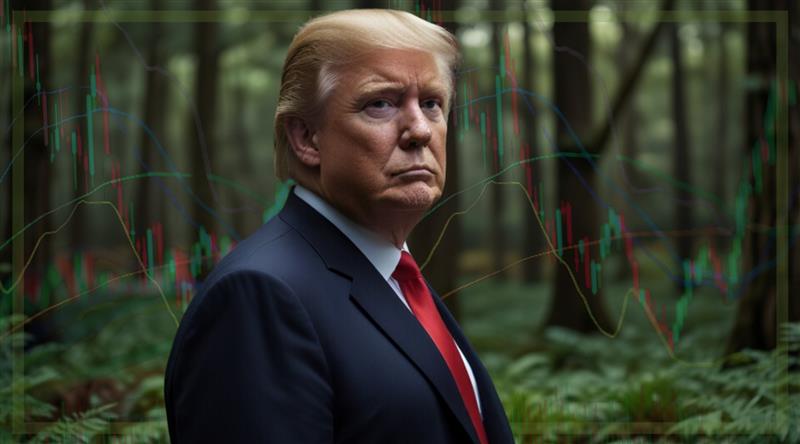ESG investing is booming. As of early 2024, global ESG assets surpassed $30 trillion in 2022 and are projected to exceed $40 trillion by 2030. This growth reflects a big shift — investors now want their money to do more than just grow. They want it to make a difference. ESG investing focuses on Environmental, Social, and Governance issues, like fighting climate change or promoting fair labor practices. But is it all real change or just clever marketing?
Critics often point to greenwashing, where companies exaggerate their efforts to appear eco-friendly. Others argue there’s no clear rulebook for what counts as “sustainable.”
And then there’s Donald Trump.
While Will Hild, executive director of Consumers’ Research — a nonprofit backed by conservative figure Leonard Leo — has described ESG as a ‘dead man walking,’ reflecting a broader conservative critique of ESG initiatives, Donald Trump’s victory in the 2024 US presidential election has cast a shadow over the future of ESG policies in the United States, as his administration is expected to support fossil fuels and potentially roll back ESG-related regulations, similar to his first term.
President-elect Trump vowed to promote fossil fuels, weaken pollution regulations and reverse Biden administration climate efforts https://t.co/PO8QrZAFIP
— Scientific American (@sciam) November 7, 2024
The Bright Side of ESG Growth
The numbers don’t lie. ESG investing is still growing strong. According to Morningstar, global sustainable open-end and exchange-traded funds saw net inflows of approximately $10.4 billion in Q3 2024, marking a significant increase from the $6.3 billion recorded in the second quarter. This shows how much people believe in putting their money into ethical causes. A 2023 Morgan Stanley survey found that 77% of individual investors are interested in sustainable investing. It’s clear that this trend isn’t going away just yet.
According to Jessica Alsford, Morgan Stanley’s Chief Sustainability Officer and CEO of the Institute for Sustainable Investing, “2023 saw sustainable funds return to their long-term trend of outperforming their traditional peers.”
“This comes on the heels of our survey of individual investors, which found that a majority look for both competitive financial returns and sustainability in their investment strategies. Our new analysis shows this can be possible,” she further commented.
Younger generations, like Millennials and Gen Z, are pushing this movement forward too, a 2021 MorningStar analysis found. They want companies to do more than just make profits. For example, the online revenue of Patagonia, a company known for its eco-friendly practices, was reported at $422.1 million in 2023. Consumers reward businesses that take real action.
A recent survey shows that a significant number of #China’s biggest #banks are now incorporating #ESG practices into their operations. For these banks, it’s a survival strategy.https://t.co/79E9nqD26b
— #DisruptionBanking (@DisruptionBank) September 25, 2024
Europe is leading the charge with strict rules. The European Supervisory Authorities (ESAs) published an update to their consolidated Q&As on the SFDR on July 25, 2024. This requires clear data on ESG performance. These efforts aim to make it harder for companies to greenwash their image. ESG regulations aim to enhance transparency and build investor trust among European asset managers.
But ESG isn’t just about profits or rules. It’s also driving real change. According to the International Energy Agency (IEA), global renewable energy capacity has seen appreciable growth, with a record-high level of clean energy coming online in 2023, including more than 560 gigawatts (GW) of renewable power capacity. ESG-focused investments have played a role in this expansion, contributing to the overall increase in green energy capacity. This proves that, when done right, ESG can create meaningful results that all can see and, perhaps, even feel.
Graph that should give us hope for the future 👇🏾
— Dr. Jeevun Sandher MP (@JeevunSandher) November 19, 2024
Clean energy installation keeps beating forecasts. The future is green. pic.twitter.com/N0ywXOkBHw
Tackling the Tough Stuff in ESG
ESG investing might be growing, but it’s not without its fair share of hiccups. The biggest thorn in its side is greenwashing. This is when companies slap a “sustainable” label on their products or services without actually doing much to back it up. Take DWS Group, a Deutsche Bank subsidiary. Back in 2022, they got hit with a $25 million fine by the U.S. SEC for exaggerating their ESG credentials. Scandals like this make investors skeptical. Without clear and enforceable standards, it’s hard to tell who’s walking the talk and who’s just talking, waiting for someone to call their bluff.
Alex Martin, senior climate finance policy analyst at the nonpartisan Americans for Financial Reform Education Fund said, “Without these rules, Wall Street will continue to get away with duping investors who want products that align with their needs and values.”
Small businesses face a different kind of struggle. Unlike big corporations with entire departments dedicated to ESG, small and medium-sized enterprises (SMEs) often lack the resources to jump on the bandwagon. A 2024 PwC survey found that approximately three-quarters of companies preparing to report under the EU’s Corporate Sustainability Reporting Directive (CSRD) are integrating sustainability into their decision-making processes. The problem isn’t a lack of willingness — it’s a lack of tools and funding. Thankfully, technology is stepping in. Platforms like Clim8 Invest use AI to simplify ESG tracking and reporting, making it more accessible for smaller players.
#ESG issues continue to increase in size and complexity. #TMT CEOs believe that failing to meet ESG expectations can lead to a loss in competitive advantage and a threat to long-term business activities. More insights in the KPMG 2024 #Technology and #Telecommunications CEO… pic.twitter.com/qzJP4vgxIW
— KPMG India (@KPMGIndia) November 25, 2024
But even with tech lending a hand, regional disparities in ESG adoption remain glaring. Developed regions like North America are significantly ahead in environmental tracking, with a high percentage of companies actively monitoring their impact, according to recent industry reports. In contrast, regions like Latin America struggle, with a significantly lower percentage of businesses tracking their environmental impact. The lack of infrastructure and regulatory support in these areas creates a huge gap that needs bridging.
“While ESG has had a challenging few years, we see the market entering a necessary consolidation phase, characterized by slower growth and gaining maturity,” Adeline Diab, Global ESG Research and Strategy Director at Bloomberg Intelligence, said. “Funds are likely to undergo a consolidation phase in the near term as the market adjusts to regulatory changes and client demand for differentiated products.”
Inconsistent standards are another headache. Investors want to compare ESG funds globally, but it’s like trying to measure apples against oranges. The IFRS Foundation, through the IASB, proposed updates to the IFRS Accounting Taxonomy in August 2024, focusing on specific standards and amendments. However, the adoption of these updates varies significantly across different countries, leaving investors facing challenges due to inconsistent application of standards.
Let’s not forget the human factor — trust. Scandals like DWS Group’s erode confidence, making people wonder if ESG is just another marketing gimmick. To fix this, the industry needs more transparency and accountability. Investors don’t just want promises; they want proof. It’s clear that for ESG to truly work, these challenges need tackling — quickly and thoroughly, so to speak.
The Trump Effect: Winds of Change?
Donald Trump’s anti-ESG stance is shaking things up. During his presidency, he rolled back over 100 environmental rules. He promised more deregulation if reelected, and now, he has. His position had already caused trouble back in October. According to Morningstar, U.S. sustainable funds saw outflows of $9 billion in the first quarter of 2024, marking a significant downturn compared to previous periods.
But globally, ESG is still thriving. In Asia-Pacific, ESG funds are projected to grow at a compound annual growth rate (CAGR) of 20.6% from 2024 to 2030. Japan’s Climate Transition Bond Program began in February 2024, aiming to provide 20 trillion yen (approximately $150 billion) over the next decade to fund clean energy and other green projects. This shows that even if the U.S. slows down, other regions are stepping up.
Some U.S. states are also pushing back. In October 2023, California enacted the Climate Corporate Data Accountability Act (SB 253), requiring companies with annual revenues over $1 billion that do business in the state to annually disclose their Scope 1–3 greenhouse gas emissions. This state-level action is a sharp contrast to Trump’s federal policies.
The @IEA just published two fascinating reports
— Simon Evans (@DrSimEvans) March 1, 2024
Here are some of the best charts
1/
Clean energy is growing twice as fast as fossil fuels pic.twitter.com/81h2cp7iGh
Experts argue that ESG has become too big to fail. “Global development reflects caution ahead of key elections in the US and Europe which will determine the pace of future green policies and encourage or discourage more sustainable practices,” said Hortense Bioy, global director of sustainability research at Morningstar.
Where Do We Go From Here?
For ESG to succeed, transparency is a must. Investors need clear and reliable information. The International Sustainability Standards Board (ISSB) has already released its initial guidelines, which became effective in 2024, with reporting commencing in 2025. These standards are designed to unify ESG reporting practices globally.
Technology will also play a definitive role. AI tools like Sustainalytics are already helping businesses collect accurate data. Blockchain is another industry disruptor. It can provide tamper-proof records of ESG metrics, ensuring accountability.
Blockchain tech has considerable potential to help corporations fulfill their ESG mandates via features such as traceability and carbon credits trading, the Consensus @ Consensus report finds.
— CoinDesk (@CoinDesk) June 9, 2023
More from the #ConsensusAtC23 report, presented by @Hedera: https://t.co/VbbH4uEG7s pic.twitter.com/KMdTRqj7J4
Policymakers are stepping in too. For instance, Germany has introduced subsidies to support industrial decarbonization, aligning more closely with U.S.-style climate policy by focusing on subsidies rather than the traditional EU regulatory approach. Additionally, SUCCA Africa has become the first African accelerator in the Race to Zero campaign, focusing on sustainability and ESG services, including consulting and training for small and medium-sized enterprises (SMEs) in West Africa. These initiatives aim to make ESG more inclusive.
Consumers are driving change as well. The 2023 Edelman Trust Barometer showed that 58% of consumers believe their choices can push businesses to act responsibly. This creates pressure for companies to not just talk about sustainability but show real results.
The future of ESG depends on delivering measurable impact. If it can align lofty goals with real action, ESG has the potential to reshape the financial world. The next few years will be crucial in proving that this isn’t just a trend but a lasting change, all things properly considered.
Author: Richardson Chinonyerem
#ESG #Sustainability #Climate #Trump















